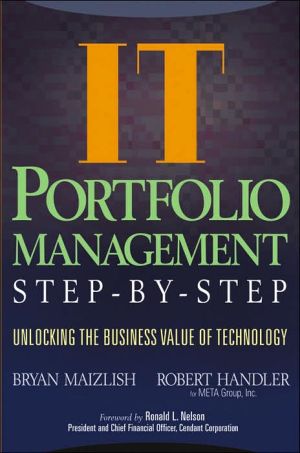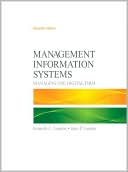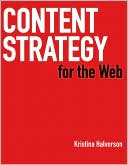IT Portfolio Management Step-by-Step: Unlocking the Business Value of Technology
Praise for IT Portfolio Management Step-by-Step\ "Bryan Maizlish and Robert Handler bring their deep experience in IT 'value realization' to one of the most absent of all IT management practices—portfolio management. They capture the essence of universally proven investment practices and apply them to the most difficult of challenges—returning high strategic and dollar payoffs from an enterprise's IT department. The reader will find many new and rewarding insights to making their IT...
Search in google:
Information technology (IT) provides inordinate value if applied properly. Identifying and implementing new value and revenue opportunities, while maximizing return based on existing investments is contingent on understanding the entire portfolio of information technology investments. Just as a financial investment portfolio requires constant monitoring and action, the investments a company has, or is making, in IT must constantly be evaluated. This need is evermore heightened in today's demanding regulatory environment. While silver bullet solutions do not exist for difficult problems, IT portfolio management provides a realistic approach to ensuring that investments in technology continue to support the needs of business.Based on the authors' combined professional hands-on IT and financial experience of over thirty years, the unparalleled input and support from an army of individuals from the leading IT market research firm in the area of IT portfolio management, extensive research and case studies from many exemplar companies, IT Portfolio Management Step-By-Step provides the closest thing to a Holy Grail solution—the first complete book ever published that presents a proven, pragmatic, and non-technical approach to simplifying the process of achieving a rationalized and business-aligned IT portfolio.IT Portfolio Management Step-By-Step encapsulates the essential ingredients novices and experts need to build or fortify an existing IT portfolio, including extensive coverage of:The comprehensive five-level IT portfolio maturity model and portfolio metricsPolicies, principles, organizational roles, and other governance aspects of IT portfolio management, including linkages to Sarbanes-Oxley and CobiTThe IT life cycle and each IT sub-portfolio in their content and contextThe eight detailed stages and specific tasks of building, step by step, the IT portfolio, replete with realities and lessons learnedCoverage of advanced IT portfolio management topics such as Monte Carlo Simulation, the Efficient Frontier curve, Real Options, Analytical Hierarchy Process, Earned Value Analysis, Balanced Scorecard, and Scenario PlanningCriteria for selecting an IT portfolio management tool vendorInsight regarding the impact of future trends and technologies on IT portfolio management
IT (Information Technology) Portfolio Management Step-by-Step\ \ By Bryan Maizlish \ John Wiley & Sons\ ISBN: 0-471-64984-8 \ \ \ Chapter One\ IT Portfolio Management: An Overview\ CHA CHA CHANGES IN THE CURRENT ENVIRONMENT\ The unabated growth in information technology (IT) spending, a primary means of economic expansion before 2000 due to large-scale enterprise resource planning (ERP) implementations, Y2K, and the hypergrowth attributed to dot.com and e-business, is, for the time being, over. In today's turbulent environment, companies face new hurdles from:\ Greater uncertainty\ Increased commoditization\ Nontraditional entrants with competitive offerings\ Shorter half-life of information (moving strategic enablers to commodity)\ Tighter spending\ New technologies\ Changing customer demands and higher levels of personalized preferences\ Multiple pricing, service, and utility models\ Government regulations, legal compliance, and safety standards\ Increased transparency of information due to the blurring between customers, competitors, and suppliers\ While many of these challenges are externally driven, the internal challenges faced by many companies include:\ Clearly defined and clearly communicated business and strategic objectives, and consensus building around these objectives\ Complexity associated with introducing and infusing change and innovation\ Identifying and managing investments across multiple divisions and business units\ Product versus service focus\ Value chain partners\ Sourcing relationships\ Cost reductions\ Responsiveness improvements\ Efficiency enhancements\ Although change will continue to accelerate and have more impact, many companies continue to either reduce or maintain current levels of IT spending. CIOs and other IT management leaders are now being called upon to justify the business value of IT. Critical capabilities to supporting the business value of IT include:\ Prioritization and alignment with the corporate vision\ Balanced investments across business units\ Pragmatic cost and risk-control mechanisms\ Rational decision-making processes\ Flexibility to reassess and rebalance priorities in the face of a fluid environment\ Adherence to mandated compliance and regulatory requirements\ Achieving growth and business value in today's challenging economy has driven many companies to focus on their core competencies: the unique and differentiated knowledge contained within their processes, technologies, relationships and extended enterprises, skills, and culture that provide a leveragable competitive advantage. Focusing on core competencies also means developing a closer alignment between business and IT, as IT represents a sizable percentage of the budget spending for companies and is quickly developing into a valuable strategic asset. In fact, according to recent research, IT spending as a percentage of gross revenues is currently 1.5% to 7.0% and represents greater than 70% of capital spending for most companies.\ FOCUS ON IT INVESTMENTS\ IT can have a significant impact on the quality of services and solutions and the performance of a company. Efficiently and effectively managed IT investments that meet business and mission needs can create new value-revenue generation, build important competitive advantages and barriers to entry, improve productivity and performance, and decrease costs. Similarly, poorly aligned and unmanaged IT investments can sink a company.\ IT investments represent a profound hole within companies. There are no other investments within a company that occupy such a large and growing expenditure yet lack disciplined management, processes, and performance measurements. However, a majority of companies are aggressively scrutinizing the amount of investment allocated to IT in an effort to cut costs, achieve economies of scale, and drive shareholder value to get more and do more for less. The primary focus on IT investments is on short-term projects and priorities with near-term benefits, delaying and in many cases eliminating long-term strategic investments.\ Concurrent to cutbacks in IT spending and a short-term focus, management within companies is demanding an increase in IT productivity, expanding IT's role from internally focused to customer facing and making IT more relevant to the business strategy as resources are scaled back. Customers are demanding more rapid, real-time, customized, total solutions, while competitors are forcing companies to frequently innovate to maintain their market position. Additionally, regulators are requiring new levels of accountability and traceability of corporate behavior (e.g., the Sarbanes-Oxley Act), prompting increasing levels of compliance. The information systems department is not immune to compliance requirements mandating microscopic examinations of areas such as careless project overruns.\ Besides deploying Six Sigma practices and cutting costs by freezing projects, laying off employees and contractors, or renegotiating supplier contracts, many companies are utilizing supply-side self-funding IT activities to get through turbulent times, including:\ Simplifying, migrating, retiring, and/or consolidating legacy systems to decrease operations and maintenance costs and increase flexibility and agility\ Standardizing, reengineering, and utilizing commercial off-the-shelf technologies and open standards for new product development to speed time to market and avoid the expensive use of proprietary technologies\ Externalizing processes through outsourcing and establishing value-network partner ecosystems and shared services, resulting in lower costs and focus on core competencies\ IT portfolio management is a tool that supports companies during times of both robust growth and economic downturn. IT portfolio management supports disciplined improvement and thrives on consistency, repeatability, and accountability. However, a key challenge for companies during periods of boom or bust is aligning to the corporate strategic intent and developing a framework for measuring, balancing, prioritizing, selecting, and flexibly changing the composition of IT investments and assets. Many companies are hemorrhaging in IT spending due to:\ A prevalence of pet projects\ A reluctance to kill projects and/or retire assets\ Too many active projects and a huge backlog of projects\ A myopic focus on exotic and cool technologies\ A lack of a detailed cataloged, organized, and aggregated view of critical versus immaterial assets\ Inconsistent and incomplete criteria to assess IT investments\ Underestimation of the total cost of ownership\ Inadequate governance\ Ad hoc program management processes\ This situation is reflected in the following survey results that highlight the shortfalls of the majority of companies in attaining optimal value at acceptable risk levels for their IT investments:\ 84% of companies either do not do business cases for their IT projects or do them on a select few key projects.\ 83% of companies are unable to adjust and align their budgets with business needs more than once or twice a year.\ 67% of IT organizations are not market ready. Benchmarking is done less frequently than once a year.\ 89% of companies are flying blind, with virtually no metrics in place except for finance.\ 57% of companies perceive they are balancing the pressures of cost cutting and IT effectiveness.\ Most companies maintain a list of more IT projects than their budgets can support. Ironically, many business and IT managers are unaware of:\ The types of ideas and concepts being worked on within research and development\ How many IT projects are in the development cycle and their alignment with the future strategic direction\ The amount of resources allocated to, or the risks associated with, each IT investment\ The reason why IT investments were initiated or the criteria used to approve IT investments\ In addition, information regarding the size and magnitude of the operations and maintenance budget as a percentage of IT spending, and how this funding is allocated among new systems versus legacy systems, is typically not readily available. Hiding IT costs associated with pet projects, political power plays that override strategic objectives, and implementation and execution of rogue systems is easy and commonplace. Unfortunately, most companies lack the discipline to continuously measure performance. To complicate matters, it is not unusual that accountability to initial assumptions made in IT investments is nearly impossible to trace, since roles, responsibilities, and ownership are vaguely defined. Welcome to the world of configuration management, change management, transition management, and governance processes at the lowest levels of maturity. It is impossible to effectively and efficiently manage IT resources without awareness and a detailed catalog of all IT investments, identifying who is accountable, and relevant metrics.\ The flaws and disconnects as discussed are manifested in the figures:\ 72% of IT projects are late, overbudget, lacking in functionality, or never delivered.\ Of the 28% "successful" projects, 45% were overbudget and 68% took longer than planned.\ 50% of managers said they could have realized value with 50% of the cost.\ Only 52% of the projects realized strategic value.\ According to the Project Management Institute, North American firms spent more than $1 trillion on IT deployments and surrendered nearly $300 billion on late, overbudget, or failed implementations during 1999-2001. Focus, direction, and control mechanisms are not core competencies within many companies. These figures are particularly alarming considering that projects and initiatives in the pipeline should represent the engines for growth, modernization, and transformation. Projects and initiatives typically average approximately 25% of the total IT budget (the remainder allocated to assets within operations in such areas as existing applications, infrastructure, people, processes, etc.). Assuming a 30% success rate, only $1 out of $14 spent by the average company's IT budget can be correlated with new benefits. This is a relatively accurate assertion.\ IT continues to subsume a larger percentage of the enterprise budget. The criticality of IT to business operations and the rising cost of downtime will increasingly impact the bottom line. As customer demands continue to increase and as companies expand their operations beyond their own facilities, it is imperative that they focus on demand-side efficiencies and provide impeccable quality, service, integrity, and continuous innovation. As a result, converting fixed IT costs into variable costs through such mechanisms as utility-based on-demand offerings and outsourcing (e.g., infrastructure, application development, application maintenance, business processes) allows companies to focus on their core value propositions. This practice has recently gained traction.\ Many companies maintain a sequential series of tightly coupled, hardwired systems that dictate business logic and processes. The resulting infrastructure is inflexible and ineffective in data aggregation and synchronization. Costly overruns are commonplace in extending or adding new processes across divergent and distributed environments. The ability to extend, migrate, refurbish, or retire systems or applications is very difficult as key dependencies, support, and constraints with other applications and systems are often unknown. Thus, it is not surprising to find multiple and redundant enterprise resource planning, supply chain management, portals, customer relationship management, middleware, and operating systems consisting of undocumented ad hoc upgrades and patches analogous to a "spaghetti" architecture.\ Technical, business, operating, system, logical, and physical views of the architecture are typically outdated or nonexistent. Misalignment between IT and the strategic intent, inability to establish a common IT architecture, and a highly redundant and undocumented as-is architecture will result in high operations and maintenance costs. Furthermore, this will limit a company's ability to rapidly respond to unforeseen events and prioritize and reprioritize investments. In today's unforgiving economy, the result of not conforming to a disciplined IT portfolio management framework is undisciplined growth and drift of business processes that are typically expressed through lack of innovation, slow market responsiveness, and dissatisfied customers. These shortfalls are exposed swiftly, causing debilitating and adverse effects on valuation and the sustainability of a company as an ongoing entity.\ To further complicate matters, the emergence of web services, business process management systems, and services-oriented development of applications (SODA), which enable more specialized, plug-in applications, are seminal elements in realizing the vision of an agile enterprise. These flexible new technologies are creating an unprecedented demand for systems to interoperate. Web services and SODA will continue to make the business and IT relationship more critical as IT continues to become increasingly more integral to business processes. The layers of abstraction added to technologies are becoming more visual and model driven. In addition, the introduction of emerging technologies or often just the hype around them (e.g., nanocomputing, grid computing, and peer-to-peer computing) will continue to add to the complexity of IT, making IT portfolio management an increasingly critical capability.\ FORMING, NORMING, STORMING: THE IT LIFE CYCLE\ Unfortunately, there is no single point of failure that is causing breakage. In fact, there are failure points across the entire IT life cycle that contribute to poor planning, execution, and alignment of projects and initiatives. According to research, fewer than 25% of Global 2000 IT staff have been formally and effectively schooled in project management. The IT life cycle is comprised of three primary phases: the IT discovery phase, the IT project phase, and the IT asset phase.\ IT Discovery Phase\ Sometimes called the fuzzy front end, the IT discovery phase occurs during the concept and idea stages of basic research. This phase matures IT investments that are typically longer term, riskier, and more uncertain than the other two phases discussed below. The IT discovery phase provides the locomotive that companies utilize to grow and transform the business. Investments in this phase are inventoried, assessed, balanced, optimized, and selected in the IT discovery portfolio.\ IT Project Phase\ Sometimes called new product development, this phase is governed by a series of stages and gates for managing the life cycle of projects. Investments made in the IT project phase typically are medium- to short-term investments that companies use to help transform and grow the business. Investments in this phase also include mandatory requirements (e.g., legal, compliance, and safety regulations). Investments in the IT project phase are inventoried, assessed, balanced, optimized, and selected in the IT project portfolio.\ IT Asset Phase\ The IT asset phase describes the portion of the IT life cycle that are currently in operations and maintenance. This phase monitors and evaluates the existing infrastructure, software, human capital management, processes, data, and information. Investments in the IT asset phase are used to help run the business and are inventoried, assessed, balanced, optimized, and selected in the IT asset portfolio.\ Shortfalls in the IT Life Cycle\ Exhibit 1.1 describes the three primary phases of the IT life cycle, the shortfalls within each of these phases, and the impact as a result of these shortfalls. The bullet points shown in the shortfall areas under the specific phases in Exhibit 1.1 do not necessarily correspond to the phases under which they reside. The majority of companies have formal return on investment, payback period, internal rate of return, and/or economic value-add metrics. However, most do not consistently apply both financial and nonfinancial measurements and processes for evaluating projects and initiatives, and most do not track metrics after implementation.\ (Continues...)\ \ \ \ \ Excerpted from IT (Information Technology) Portfolio Management Step-by-Step by Bryan Maizlish Excerpted by permission.\ All rights reserved. No part of this excerpt may be reproduced or reprinted without permission in writing from the publisher.\ Excerpts are provided by Dial-A-Book Inc. solely for the personal use of visitors to this web site. \ \
Ch. 1IT portfolio management : an overview7Ch. 2Planning for IT portfolio management : ready, aim, then fire39Ch. 3People and governance : the most important success factors of IT portfolio management65Ch. 4IT portfolios and their content in context107Ch. 5Building the IT portfolio175Ch. 6The IT portfolio management market and industry provider assessment methodology285Ch. 7Final thoughts321








